- Не дом и не улица
BREED ID: basic understanding, perspectives and stages for the Yakutian Laika breed
Genetics webinar
Webinar was held on the initiative of the National Breed Club of Yakutian Laika
Present: Moscow, Yakutsk, Tyumen, Sochi, Kharkov, Krasnodar
Lecturer:
General Director of the Center of Veterinary Genetics "Zoogene"
Anton Vladimirovich Markov
Writer Elena Ramenska
Question:
Each society of dog breeders thinks about the future of their breed’s development, and the direction which the society of dog owners will take, here we mean Yakutian Laika breed, here is the creation of the genetic profile (passport) of the breed, or Breed ID.
What is understood in science and practice under this term, what technologies are used for this purpose, how is the research going on, how reliable are the results and what kind of experience is there in Russia and, in particular, in the Zoogene laboratory in this area?
Answer:
The idea of typing breeds appeared about 10 years ago and approximately 5-7 years it became largely commercialized. Before that it was mainly the subject of fundamental science, when the study of the origin of breeds, not by historical, but molecular data, was rapidly developed.
The notion of a genetic passport is most often used in case of typing in hereditary diseases it may include typing in colors and coat length; but it won't be a unique individual as you can have a lot of dogs free of disease with the same color and coat length. According to genetics and these tests they won't differ in any way, therefore, we do not use the term "genetic passport", but use the term identification of the breed.
When identifying the breed a set of markers is used which has no meaning in terms of diseases or anything else. It's just a unique genetic code, which when used can clearly identify an animal.
There are two systems now: the old one established in most laboratories, this is used when we are talking about the establishment of kinship - the genetic identification of the animal within the breed. Between the breeds it can also be used, this system uniquely identifies the animal, but it does not show exactly the genetic uniqueness of the breed. DNA blocks, through which identification takes place within the breed and the establishment of kinship, are called loci. Currently from 18 to 24 loci are used simultaneously, together they uniquely identify each animal. This system is absolutely identical to the same system for a human (not technically, but logically). The disadvantage of this system is that, unlike humans, dogs have a very high degree of inbreeding. In many cases dogs are very closely related to each other within the breed, so the greater number of simultaneously used loci applied the greater reliability of identification of the dog takes place. In some European and American clubs, the identification of the "incoming dog" (purchase, birth of puppies) is mandatory.
When we talk about the identification of the breed, this system does not work, because all animals within the breed will differ in the above loci.
At one time a system such as CanFam was set up and which uses modern methods that have spread in the last 3 years. In the case of the use of SNP (single nucleotide polymorphism) - each chromosome of each dog is sequenced and a definite sequence is revealed. A certain reference (usually the DNA sequence of the boxer, the first sequenced dog) is taken and compared to all other animals. All 39 (38 + x) chromosomes of dogs are compared in the SNP system by dots (approximately tens of thousands of dots).
It looks like a long row of letters:
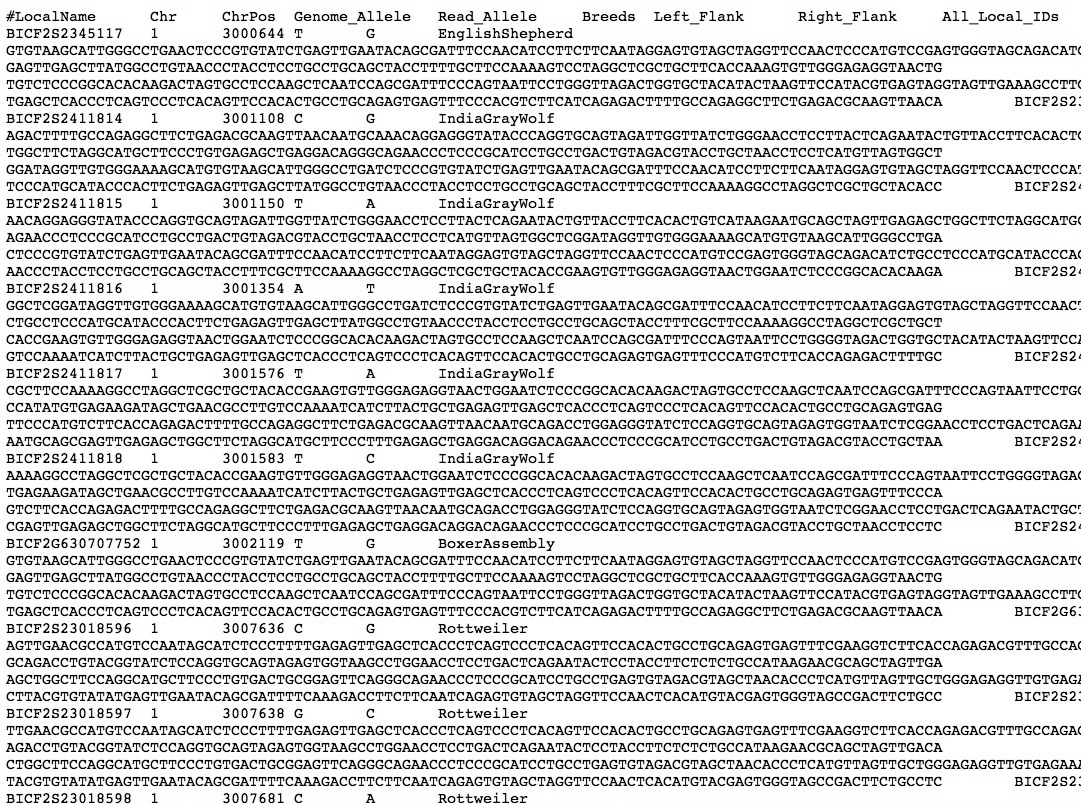
It looks pretty scary and is hardly readable. A computer processes it because just scrolling through the SNP list will take quite a while. Every few lines with a set of letters is a part of one dog chromosome with indication of its breed. The size of the haploid genome of one dog is 2.4 GB.
Letters are just letters denoting one of the billions of nucleotides in DNA: just as the letters form the words in books - nucleotides form genes (words / genes are formed by a unique combination of letters / nucleotides).
A certain sequence of letters is set for each breed, which distinguishes it from the reference. This is such a huge matrix several tens of thousands of letters are used for each chromosome, and for each breed. Thus all breeds are typed. Then the breed / dog is identified:
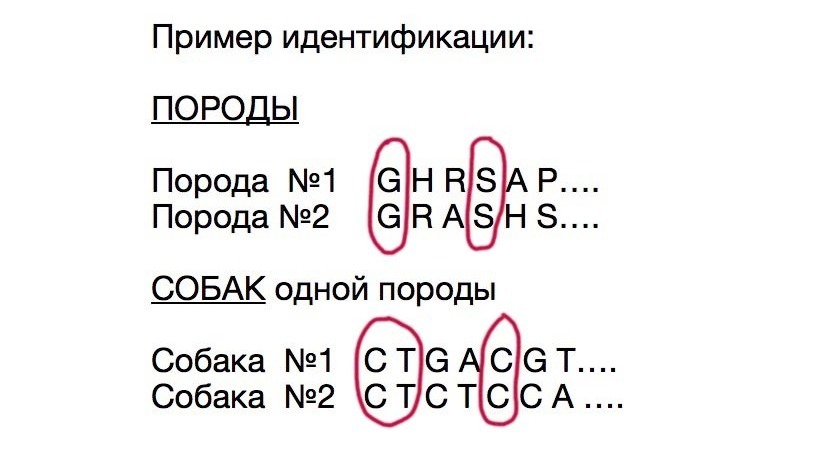
Between the two dogs there are certain letters that do not differ, and there are letters that do not match. According to mismatched letters, it is impossible to determine the breed, and dogs cannot be compared, because these are variations within one breed. A fairly large number of dogs are taken, in order to exclude such variations. Then they choose exactly those letters that are identical within the same breed. Further, on the basis of this, a matrix is formed, characterizing this particular breed, between the breeds these letters will always be different.
Question:
Is the sequence of letters calculated by sequencing each chromosome?
Answer:
Now there is a slightly different approach to this that is not whole genomic sequencing, and Illumina company simplified the task by developing special chips that are a "laboratory glass" (6cm x 2cm). There is a set of dots on this chip that is collected to identify one dog and each dot means a separate letter. By the color of this dot, the computer reads this sequence of dots and based on this sets the sequence of letters. It is known that the dots are analyzed in the same places and there can be no mistakes. About 20 dogs can be analyzed only on one chip. Thus, there is no need to use a whole genome sequencing every time. The same chips exist for both diseases and colors but they have a different purpose and accordingly other dots are analyzed on them. Thus there is a certain sequence of letters for each breed.
The chip for identification looks like this:
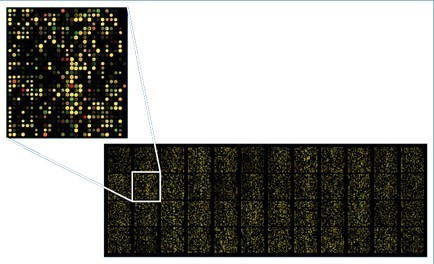
It is a rather complicated procedure technically. For example, a human genome has been read long ago as well as dog and cat genome and etc. A huge number of genomes have been decoded, but it doesn't make any sense. In fact it is almost impossible to process and interpret the whole genome. For instance the genome of a living being contains on average 4-5 billion letters: the dog genome contains 2.4 billion letters - it's about 2-3 thousand of volumes of "War and Peace" by Leo Tolstoy. For processing of the genome such a huge amount of information generated by a sequencer requires large computational resources to make it clear - this is the level of big server stations.
Illumina provides its resources for processing genomes using the Mars panel and designed special chips.
Currently, one of the panels used is the Wisdom Panel developed by Mars Veterinary (UK) which is offered by Illumina the manufacturer of sequencers and sequencing kits and the so-called chips.
To identify the breed you need at least 50 to 300 dogs of this breed.
As for Russia we don't practice it here. In fact there are about 100 genome sequencers in Moscow and 10 in St. Petersburg and there are some in Novosibirsk. Due to their high cost they are used for fundamental scientific purposes and in particular for commercial purposes. Many companies have appeared that offer genetic tests for human mainly on a genetic predisposition to diseases. But there are no companies providing the possibility of using sequencers for animals.
You can use the resources of Illumina for analysis on their platform, you can buy microchips that means we send the selected and prepared DNA to this company for analysis. They calculate a row of letters of a number at least 20 thousand, which is enough to identify the breed. Another question is that this row needs to be compared with other breeds, for this purpose there is a resource of the Brouder Institute which using its resources runs our sequence through the known data base with already described breeds.
This will be the Breed ID. This database will give you the result that your breed is similar to for example the Alaskan Malamute by 40%, Samoyed by 50%, Boxer by 5%. This is normal because the breed can never be absolutely unique. It will coincide with some letters anyway.
When determining the purebred genetics of dogs this service is now in demand. There are questions when one dog is 90% consistent with the breed, the other one is 91% and it means that one breed is purer the other on. This is not true. The answer is that dogs are of the same breed, that's it.
You have a completely different task, you need to get the whole picture that is characteristic of your breed. You eventually need to attain access to the CanFam 2.0 database at the Brouder Institute (link above), this should be done officially, the average person cannot put the breed into the database. Following guidelines it is possible that the Yakutian Laika breed will be put on this long list of SNP-pages.
Step by step:
- Collection of biomaterial (Zoogene) http://zoogen.org/eng/index.php/yourself-collection/buccal
- Extraction of DNA (Zoogene)
- DNA analysis to get a sequence of letters (Illumina) or a Russian company with the purchase of Illumina chips
- Inclusion of the breed in the database CanFam 2.0 (Broad Institute)
Nowadays nobody does it for dogs in Russia.As far as it concerns man everything works.
There are no problems with the devices, there are connections with firms that can do this in Russia. There is a problem with purchasing chips because they are quite expensive. At the moment it is difficult to speak about the price.
Such practice is not that popular here in Russia and due to the specific procedures it can be quite expensive.
Our center will look for opportunities abroad and in Russia as well as negotiations over the cost.
Question:
For better understanding of our dog owners we need to clarify the following issue. Our Portuguese friends made a genetic test of Yakutian Laika which showed the mixture of Samoyed (25%) and unknown breeds (75%) in the dog's blood. So some owners came to the conclusion that Samoyeds were mixed in our breed.
Answer:
The following picture illustrates the origin of the breeds:
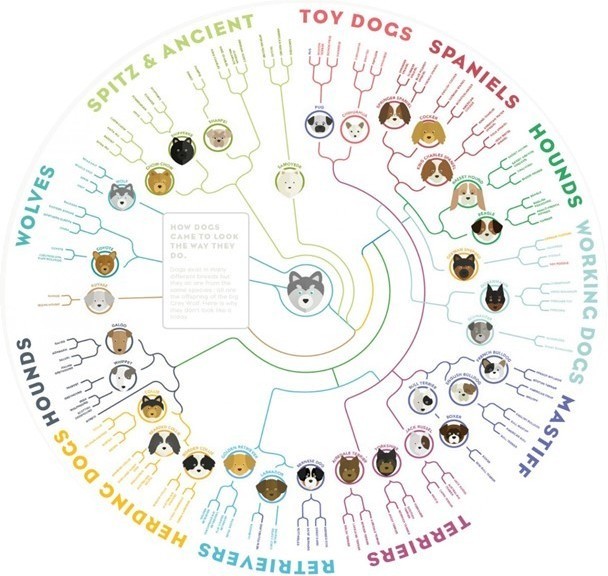
This test absolutely does not mean cross-breeding. The fact that the analysis showed that your dog is 25% similar to the Samoyed means only one thing: Samoyed is the closest breed to yours and that you have a common ancestor. It's quite logical because all these dogs are northern, and most likely they have one common ancestor. Dogs descended from wolves, as we know there are breeds mixed with jackals and coyotes but the basic species is a wolf. In your case it's a polar wolf I suppose. By the way northern dogs are the closest to the genotype of the wolf:
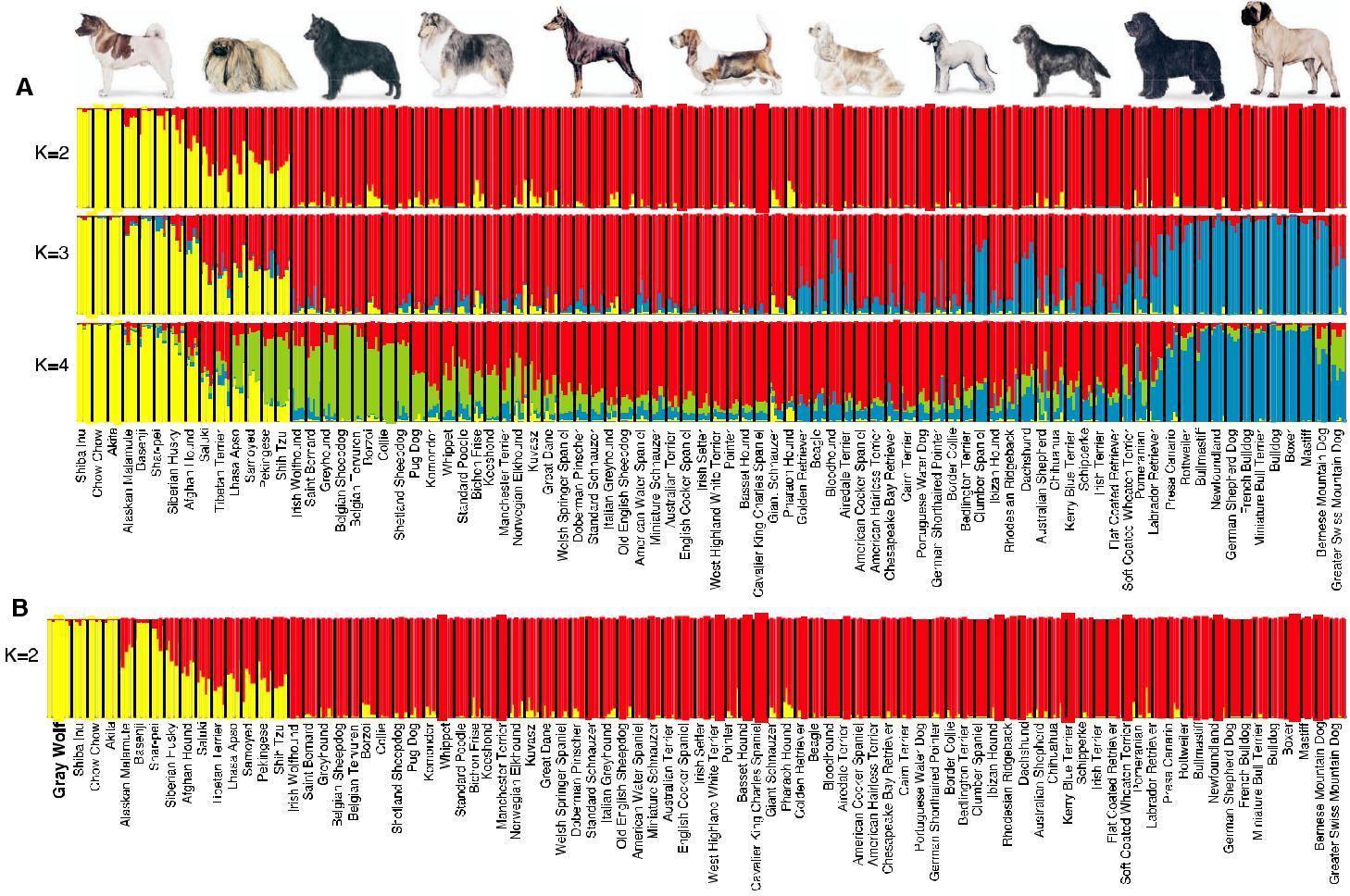
The wolf is defined by yellow color, the closest breeds to it according to genetic tests of breeds were Asian-northern breeds and the most remote (red color) -European dogs that are the bulldog, the boxer, the German shepherd.
25% - in fact is a very good indicator. Firstly it means that your breed is different from other breeds, you do not belong to any particular breed; and secondly it shows that your dog has just some kind of kinship with Samoyed.
Such analysis can mislead ordinary people - it says nothing about how many breeds in your dog are mixed, it just shows how much your dog looks like the other one, no more! 2% of poodle - this does not mean that your dog has only 2% of the poodle, but it just looks like a poodle by 2%. The same with people who are more or less similar to each other and we also differ from each other by some percentage. This is the tricky thing of the Breed ID - it is needed to describe the breed to show that your dogs are within the same breed - that's it.
It's clear that if it shows that 50% of Laika and 50% of dachshunds then most likely it's a cross between Laika and Dachshuгnd but it's impossible. So for a purebred dog there won't be such a result: there will always be 80-90% of its "own" breed plus some random similarity with others. Metisation breaks this proportion very tough - on the level of 40-50% of similarity.
Question:
We discussed the problem of identification of the breed with Yakutian geneticists from the Yakutsk University who are working on the identification of Yakutian dogs on the basis of the Korean Institute. Korean geneticists believe that indigenous northern dogs have the most ancient markers because on our territory archaeologists have found and continue to find the remains of dogs with mammoths that are very ancient. Experts told us that the Breed ID and comparative analysis are rather long procedures, aren't they?
Answer:
No, the research process doesn't take long. It usually takes 2 days. The duration of the analysis depends on collecting of samples. You cannot put the DNA of one dog on one chip which is very expensive, it is not economically profitable. Therefore we need to put the necessary amount of information so that it fills the entire chip. As for the aboriginal nature of the breed I completely agree, above I have proved the antiquity of the Asian-northern breeds.
Question:
What tests for genetic diseases can be recommended for our breed?
Answer:
Colors are not something separate for the breed, they are common to all breeds where diseases are always breed-specific meaning they are common in one breed. Some diseases that have appeared long ago spread to a large number of breeds. The same pra-PRCD (progressive retinal atrophy), DM (degenerative myelopathy), drug sensitivity of MDR (gene multiple drug resistance), malignant hyperthermia (reaction to anesthesia) are found in many breeds. I note that the last two diagnoses are not a disease but it is an animal's reaction to drugs.
Without proving the presence of any mutations in your breed there is no point in recommending testing. The standard approach to the recommendation is this: either by a large mass sample to find the carrier of the mutation that means roughly speaking screening all dogs for all. This option is quite expensive and the result is unknown - we get / do not get (find / do not find a mutation). Another option (ideal one) is to find a sick animal with a clinically diagnosed disease and analyze it. Then if we find a mutation we say - yes, this disease occurs in this breed. If we do not find a mutation the question remains open then.
Technically analysis for any disease is also carried out on chips there dots are placed on these diseases. Another question is that none of the known diseases have been described for your breed.
I suspect that your dogs are very healthy, I have such a suspicion :-)), because they are endemic, there is no cross in their breed. Until the mutation is found, we cannot say that there is a hereditary disease in your breed. That's why we won`t recommend anything specific to you. If you wish, you can make tests for well-known and widespread diseases: PRCD, DM - degenerative myelopathy, MDR - these are ancient mutations, which I repeat occur in a very large number of breeds and it is possible that they are in your breed. After such tests you are most likely to find these mutations, another question - what is the point, if they are in most breeds? What is found in Samoyeds, Malamutes and Huskies - pra-XL and, perhaps, purely by kinship it makes sense to test your dogs on pra-XL. But it's not a recommendation in terms of the risk of some dangerous disease but it's a test to find this mutation.
I do not support the idea of screening all dogs for all diseases.
For example PRCD has about 15 described mutations (a constantly growing list), one of them is pra-XL found in dogs of northern origin. Testing the dog for this disease you will get the result that your dog is clear on this mutation. But it doesn't mean that your dog will not get retinal atrophy afterwards caused by another mutation PRCD that was not described earlier. It just means that this mutation is in a different place.
Only after detecting a mutation in the affected dog we can talk about the occurrence of the disease in this breed.
When we use genetic analysis of a dog that has symptoms (preferably with a doctor's report), we do it for FREE. Moreover, the owner can contact us anonymously, without indicating the names of the dog and the owner, if he does not want to advertise this fact.
Question:
Is there a genetic test to identify a predisposition to absence / loss of hearing?
Answer:
The genetic reasons for the absence / loss of hearing in humans are much more studied than in other animals, particularly in dogs.
For dogs the main reason now is the underdevelopment of the auditory nerve and also the inner ear, which is caused by violation of imperforate neural tube during embryogenesis. Visually this is most often specifically shown as pigmentation features: large white areas on the body and primarily on the head.
This is due to the fact that the pigment cells are the derivatives of nerve cells and after the formation of the neural tube these cells migrate into the skin epithelium and become melanocytes. If the cells did not manage to get into the epithelium there is a reason to suspect that the neural tube did not have time to fully form, and the ear is just the last forming organ associated with the nervous system. This is due to the fact that pigment cells are derivatives of nerve cells and after formation neural tube these cells migrate into the skin epithelium and become melanocytes. If the cells did not manage to get into the epithelium - there is reason to suspect that the neural tube did not have time to fully form, and the ear - just the last forming organ associated with the nervous system.
Despite the fact that quite a lot of genes involved in the development of hearing are known, specific mutations affecting the hearing, as far as I know, are not described.
So in fact the main criterion for a dog to fall into the risk group of hearing loss is the color.
The main diagnostic tool here is the Baer test - a very good test that allows you to objectively understand whether the dog hears or not, but it won't reveal the causes of deafness.
Question:
We have started work on the genetic analysis of coat colors. We recommend that all our owners do this analysis for gene A and the analysis for gene K, as well as for the length of the coat. This is necessary for our research of what colors we have in the breed, how inheritance occurs, and prof. Sotskaya M.N. helps us with this. This reseach will be a separate scientific work. The basic points for the colors will become the breed standard. Over time our breed becomes more diverse in color.
The population brought from the North originally was grey, grey-white. Then gradually the color began to darken and mostly black dogs appeared then white dogs (actually sable color), white dogs with black spots (extreme degree of spotting), and then dogs with specks appeared followed by brown and red dogs. When we began to study the documentation about northern dogs (it turned out to be quite a lot in three centuries), it turned out that the red color in the description of the 19th century was indicated but as an extremely rare, atypical color.
Answer:
You need to exclude the possibility of crossbreeding which goes without saying. The color can only come out as a result of inbreeding. While dogs lived in their population the selection took place naturally and such colors could simply be eliminated (disappear).
The main thing for you now is to understand what colors are to expect and when you know the color genetics, you can easily get rid of extra colors and remove them from the breed, it won't be a problem for you anymore.
**********
BREEDERS AND OWNERS!
NBC “Yakutian Laika” recommends the following color analyzes:
Collection of biomaterial and mailing:
http://zoogen.org/rus/index.php/yourself-collection/buccal
Analysis cost:
- Gene A – 2000 rub
- Gene K – 1750 rub
- to length wool – 1850 rub
_______________________
5600 rub. - 30% = 3920 rub.
(to receive a discount, indicate in the column the customer of the NBC "Yakutian Laika")
To get into the Yakutian Laika gene pool, at least one analysis should be submitted, then your dog’s DNA will be stored in the base of the laboratory of the center “Zoogen”.